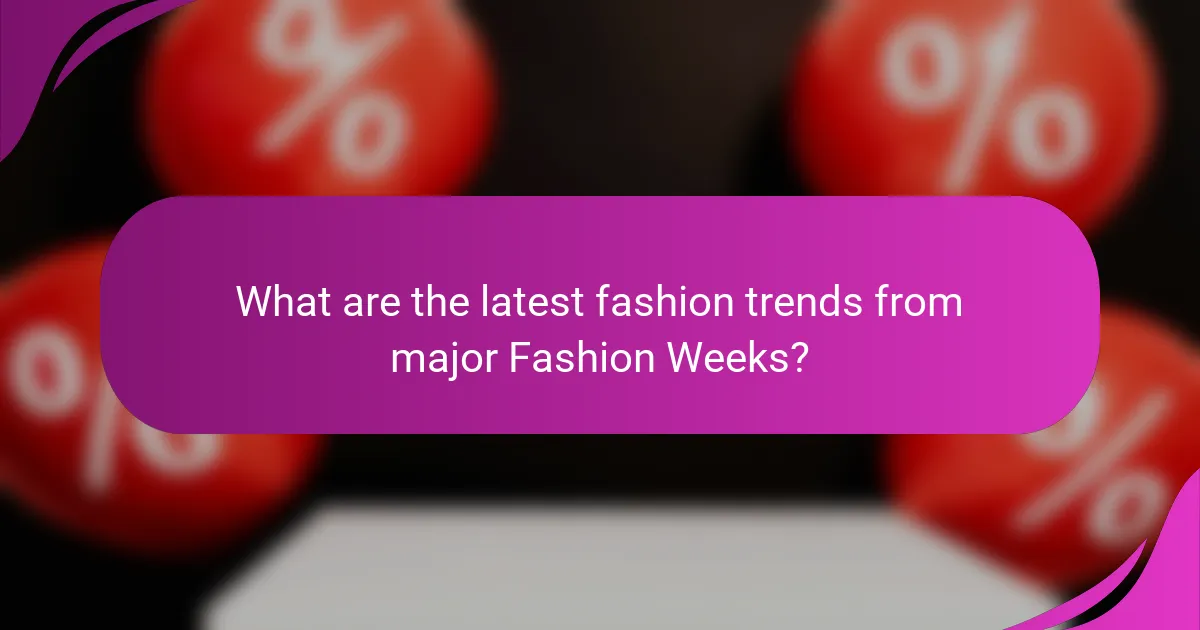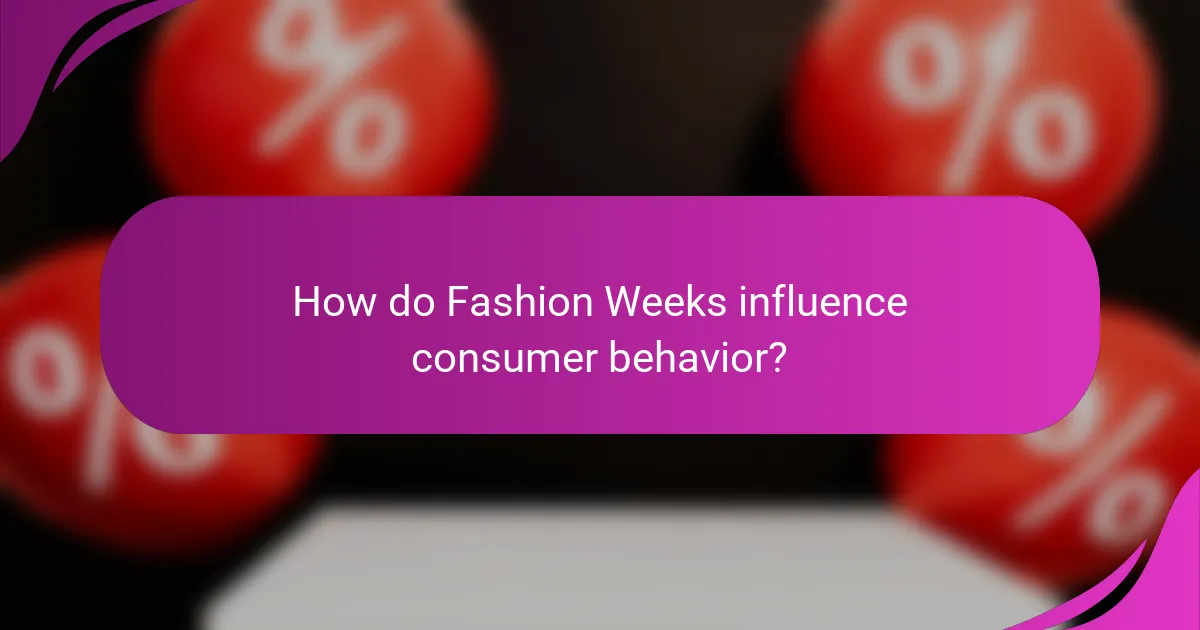Fashion Weeks serve as pivotal platforms for unveiling the latest trends that merge bold aesthetics with sustainability, reflecting contemporary social values. As designers innovate with materials and styles, these events not only influence consumer behavior but also set the stage for purchasing decisions, driving the industry’s evolution in response to market dynamics and technological advancements.

What are the latest fashion trends from major Fashion Weeks?
The latest fashion trends emerging from major Fashion Weeks highlight a blend of bold aesthetics and sustainability. Designers are increasingly focusing on innovative materials and styles that reflect contemporary social values while appealing to diverse consumer preferences.
Spring/Summer 2024 trends
Spring/Summer 2024 trends showcase a vibrant mix of colors and textures, emphasizing lightness and fluidity in fabrics. Expect to see oversized silhouettes, playful prints, and a resurgence of 90s-inspired styles. Key pieces include flowing maxi dresses, tailored shorts, and statement accessories that elevate simple outfits.
Additionally, sustainability remains a core theme, with many designers opting for eco-friendly materials and ethical production practices. This trend is not just a passing phase but a fundamental shift in how fashion is conceptualized and created.
Fall/Winter 2024 trends
For Fall/Winter 2024, the focus shifts to layering and rich, warm tones that evoke comfort and sophistication. Textured fabrics like wool, leather, and velvet are prominent, often combined in unexpected ways. Key items include structured outerwear, chunky knitwear, and tailored trousers that offer versatility for various occasions.
Dark color palettes, including deep greens, burgundies, and classic blacks, dominate the season, providing a stark contrast to the lighter hues of spring. Accessories such as wide-brim hats and knee-high boots are essential for completing these looks.
Key designers influencing trends
Several key designers are shaping the current fashion landscape, including established names and emerging talents. Brands like Gucci and Balenciaga continue to push boundaries with avant-garde designs, while newer labels like Peter Do and Telfar are gaining recognition for their unique perspectives and commitment to inclusivity.
These designers not only set trends but also influence consumer behavior by promoting a more conscious approach to fashion. Their collections often reflect broader cultural movements, making them pivotal in the industry’s evolution.
Color palettes and patterns
Color palettes for the upcoming seasons are characterized by a mix of bold and muted tones. Spring/Summer 2024 favors bright pastels and vibrant neons, while Fall/Winter 2024 leans towards earthy shades and jewel tones. Patterns are equally diverse, with florals, geometric designs, and animal prints making a strong statement.
When selecting colors and patterns, consider how they complement your personal style and the occasion. Mixing and matching different patterns can create a dynamic look, but aim for balance to avoid overwhelming your outfit.

How do Fashion Weeks influence consumer behavior?
Fashion Weeks significantly shape consumer behavior by setting trends that influence purchasing decisions. These events showcase upcoming styles, which consumers often adopt as they seek to stay fashionable and relevant.
Impact on retail sales
Fashion Weeks can lead to substantial increases in retail sales, particularly in the months following the events. Retailers often report a spike in demand for items that were prominently featured on the runway, with some experiencing sales growth in the double digits.
For example, a brand that showcases a new collection during Fashion Week may see a 20-30% increase in sales for those specific items as consumers rush to emulate the latest looks. This trend is especially pronounced in major fashion capitals like New York, Paris, and Milan.
Shifts in consumer preferences
Consumer preferences often shift dramatically after Fashion Weeks, as attendees and viewers are exposed to new styles and concepts. This exposure can lead to a rapid adoption of trends, such as specific colors, fabrics, or silhouettes.
For instance, if a particular designer introduces oversized silhouettes, consumers may begin to favor similar styles in their own wardrobes, leading to a broader market shift. Retailers must stay attuned to these changes to align their inventory with emerging preferences.
Social media’s role in trend adoption
Social media plays a crucial role in the adoption of trends showcased during Fashion Weeks. Platforms like Instagram and TikTok allow influencers and fashion enthusiasts to share their interpretations of runway looks, amplifying their reach and impact.
As consumers engage with these platforms, they often seek to replicate styles seen online, which can lead to viral trends. Brands that leverage social media effectively can capitalize on this momentum by promoting similar products, thereby driving sales and enhancing brand visibility.

What are the key market dynamics in the fashion industry?
The fashion industry is influenced by various market dynamics, including consumer behavior, technological advancements, and economic conditions. These factors collectively shape trends, pricing strategies, and overall market growth.
Global market growth statistics
The global fashion market has seen substantial growth, with estimates suggesting it could reach several trillion USD in the coming years. This growth is driven by increasing consumer spending, particularly in online retail, which has expanded rapidly.
Regions such as North America and Europe continue to dominate, but Asia-Pacific is emerging as a significant player, contributing to a notable share of the market. The rise of e-commerce has been a key factor in facilitating this growth, allowing brands to reach a broader audience.
Emerging markets in fashion
Emerging markets, particularly in Asia, Africa, and Latin America, are becoming crucial for fashion brands seeking growth. Countries like India and Brazil are experiencing a rising middle class, which is driving demand for both luxury and affordable fashion.
Brands are increasingly tailoring their strategies to cater to local tastes and preferences, often leveraging social media and local influencers to engage consumers effectively. Understanding cultural nuances is essential for success in these diverse markets.
Impact of sustainability on market dynamics
Sustainability is reshaping the fashion industry, influencing consumer preferences and brand strategies. Many consumers now prioritize eco-friendly products, pushing brands to adopt sustainable practices in sourcing, production, and distribution.
As a result, companies are investing in sustainable materials and transparent supply chains, which can lead to higher production costs but also create competitive advantages. Brands that successfully communicate their sustainability efforts often see increased customer loyalty and market share.

How do designers prepare for Fashion Weeks?
Designers prepare for Fashion Weeks by meticulously planning their collections and marketing strategies. This preparation involves a series of steps to ensure their designs align with current trends and effectively reach their target audience.
Collection development process
The collection development process typically begins months in advance, often up to six months before the event. Designers conduct trend research, analyze past collections, and gather inspiration from various sources, including art, culture, and street fashion.
Once the theme is established, designers create sketches and select fabrics. Prototyping and fittings follow, allowing for adjustments based on fit and style. This iterative process ensures that the final collection is cohesive and ready for presentation.
Marketing strategies for Fashion Week
Effective marketing strategies for Fashion Week include building anticipation through social media campaigns and influencer partnerships. Designers often share sneak peeks of their collections to engage potential customers and generate buzz.
Additionally, hosting exclusive events or pop-up shops during Fashion Week can enhance visibility. Collaborating with fashion publications and securing press coverage are also vital to reaching a broader audience and establishing brand presence.

What are the prerequisites for attending Fashion Weeks?
To attend Fashion Weeks, individuals typically need industry credentials and must navigate specific registration processes. These prerequisites ensure that attendees are relevant stakeholders in the fashion industry, such as buyers, press, and influencers.
Industry credentials required
Industry credentials are essential for gaining access to Fashion Weeks. Attendees usually need to provide proof of their role within the fashion sector, such as employment verification from a recognized fashion brand, publication, or agency.
Common credentials include press passes for journalists, buyer identification for retail representatives, or invitations from designers. Having a well-established online presence, such as a professional website or active social media profiles, can also enhance credibility.
Registration processes for buyers and press
The registration process for buyers and press varies by event but generally involves submitting an application with supporting documents. Buyers may need to demonstrate their purchasing power and intent to place orders, while press representatives often submit samples of their work.
Many Fashion Weeks require online registration through their official websites, where applicants can fill out forms and upload necessary documentation. It’s advisable to register well in advance, as spaces can be limited and fill up quickly.

How do Fashion Weeks adapt to digital trends?
Fashion Weeks are increasingly integrating digital trends to enhance accessibility and engagement. By leveraging technology, these events reach broader audiences and create immersive experiences that traditional formats cannot match.
Virtual runway shows
Virtual runway shows have become a staple of modern Fashion Weeks, allowing designers to showcase their collections online. These shows often feature high-quality video production, enabling viewers to experience the fashion as if they were attending in person.
Brands can host live-streamed events or pre-recorded presentations, catering to different audience preferences. This flexibility helps designers reach global audiences without the constraints of physical venues, significantly expanding their market reach.
Digital marketing strategies
Digital marketing strategies play a crucial role in promoting Fashion Weeks and engaging with audiences. Social media platforms, influencer partnerships, and targeted online advertising are commonly used to generate buzz and drive attendance to virtual events.
Fashion brands should focus on creating compelling content that resonates with their target demographic. Utilizing analytics tools can help track engagement and optimize campaigns, ensuring that marketing efforts yield the best possible results.


